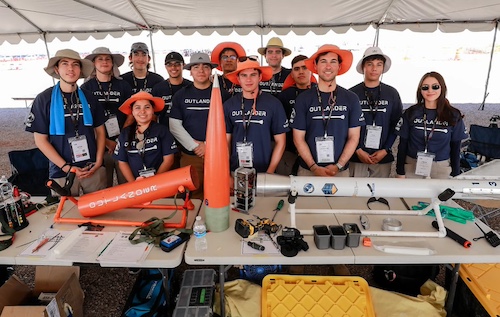
UTEP Rocket Team Soars to New Heights in Third Year at Spaceport America Cup
Rocketeers take on new, more challenging category at competition
Many qualities — including engineering skill, teamwork and flexibility — matter to a team’s success in the Spaceport America Cup, a collegiate rocket competition held each year near Truth or Consequences, NM. But one quality was particularly necessary this year for UTEP’s Sun City Summit Rocket Team: patience.

“Waiting was the hardest part,” said Andres Vicario, a senior studying electrical engineering who was one of this year’s team leads.
For the student rocketeers, the Cup was the culmination of a year of work designing and building a functional rocket that could, for the first time, reach 30,000 feet rather than 10,000; the team participated in the 10,000 feet rocket launch category in their first two years at the competition.
“The 30k category is inherently more challenging than the 10k,” Vicario said. “There is a stronger acceleration, bigger engine, faster speeds. These variables become crucial in the overall design and stability of the rocket.”
The team specifically competed in the 30,000 feet commercial bracket this June, one of six competition categories based on launch height (10,000 feet or 30,000 feet), type of propulsion fuel (solid, liquid or hybrid) and how the propulsion fueling system was developed (commercially purchased or developed by students).
In preparation for the four launch days, the 13-person team from UTEP woke up around 1:30 a.m. each day and drove from their hotel in Las Cruces to Spaceport America, a remote facility built by the state of New Mexico to serve as a commercial launchpad for satellites, spaceships and other space-bound vehicles. Preparing for launch required that the team spend hours under tents in the hot June weather assembling the rocket, completing a safety inspection and waiting in a queue along with other student groups.
Difficult weather conditions, including high winds, rain and a historic dust storm, created unexpected challenges and delayed the process for many teams. On the first launch day, the UTEP rocketeers went through the full assembly and inspection process, met with judges from the Experimental Rocket Sounding Association, which manages the cup in tandem with Spaceport America, and set up at the launchpad before ultimately having the launch called off due to weather conditions.
That evening, they drove back to Las Cruces in the middle of a massive dust storm — known as a “haboob” — that swept through central New Mexico, causing several accidents. Thankfully, the team made it back to Las Cruces safely.
The next day, the team set up again on the launchpad after an hours-long process, only to have the launch canceled for the second time. On the third day, anticipating bad weather, they assembled their rocket and left it in a secure container at the Spaceport site.
On the fourth and final day of the competition, the team finally launched early in the morning. Their rocket, Outlander, soared in a perfect arc to 28,000 feet, only slightly short of their 30,000-foot goal. At its maximum velocity, the rocket traveled at more than 1,200 miles per hour.
Launch complete, a small group set out on foot into the high desert surrounding Spaceport America to recover the rocket’s components, which were designed to separate and release a parachute to slow the descent to earth. Outlander landed only about half a mile from their camp, so the recovery process was quick and painless.
Sun City Summit’s members demonstrated exceptional patience as they waited to see the results of their hard work and navigated the changing weather. Ramiro Alcoverde, a senior studying aerospace engineering, said it was his first year at the Cup.
“The team has been very welcoming, so I’ve enjoyed it,” he said. “If you get stuck on a problem, there’s always someone who can help you. The experience of learning by doing and coming up with solutions using limited resources has for sure made me a better engineer.”
Asked whether the challenging conditions and long wait were worth it, Valeria Loza Arango, a senior studying mechanical engineering who was participating in her second year at the Cup, said: “Totally.”
Last Updated on June 28, 2024 at 12:00 AM | Originally published June 28, 2024
By Hannah Hollandbyrd UTEP Marketing and Communications
